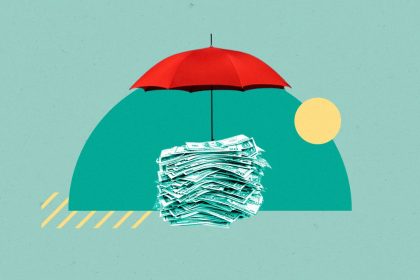Key takeaways
- Traditional personal finance goals can be difficult — if not impossible — to achieve on a low income.
- Just because you can’t meet those goals doesn’t mean you can’t make goals that work for you.
- To save more money on a low income, adjust your goals, track your spending, pay yourself first and look for opportunities to further your education.
For Andrea Schrag, a 45-year-old working mom in rural Kansas, saving feels impossible — because, for her, it is.
Schrag is the only earner in her household, as her husband is a full-time student. Her job in food services, which allows her to work while her kids are in school, pays $1,200 a month. By using their existing savings from before her husband began school, student loans and food stamps, Schrag says her family is able to scrape by with nothing extra to save for the future.
“I’ve been in situations where we’ve been able to save money, and now we really just can’t,” Schrag says. “People assume it’s because you’re lazy.”
Saving more, paying off debt and investing in your future are all key pillars of personal finance. But it can be downright impossible to do those things if, like Schrag, you don’t make enough to both pay your bills and have any money left over to save.
And saving may have become even tougher this year. Rising prices, tariffs, high credit card interest rates and expensive housing have all locked the lowest-income households out of the ability to build emergency savings and prepare in case of economic hardship. Experts predict the U.S. has a 1-in-3 chance of a recession in the next year, according to Bankrate’s Q1 Economic Indicator Survey, and without the ability to save, many people will find it hard to recession-proof their finances.
In today’s economic landscape — marked by market volatility, inflation concerns and tenuous job security — financial decisions have never felt more consequential. Our Navigating Now series cuts through the noise with expert guidance and targeted advice for diverse financial situations —whether you’re struggling to build savings amid rising costs, protecting retirement funds during market volatility or securing your income in an uncertain job landscape.
Other articles in the series:
Despite the best intentions, saving remains a challenge for many households in 2025
As they face a variety of intense economic pressures, Americans overall are feeling pessimistic about their incomes and future financial situations. At the end of 2024, nearly one-quarter (23 percent) of U.S. adults said they expected their financial situation to be worse in 2025, according to Bankrate’s Personal Finances Outlook Survey. Low-income Americans feel worse about their situation than those in higher income brackets: 24 percent of people who make under $50,000 per year say their personal financial situation in 2025 will be worse, compared to only 20 percent of those making $100,000 per year or more.
The problem isn’t that low-income people just aren’t working enough. Many full-time jobs just don’t pay enough for many people to live comfortably. As of 2024, a full-time worker in the 25th percentile of income (or the bottom 25 percent of American incomes) makes $42,328 per year or less, according to the U.S. Bureau of Labor Statistics (BLS). That’s $3,527 per month before taxes, but the average national monthly rent alone is around $2,000, according to Bankrate’s Rent vs. Buy Affordability Study. After taxes, low-income workers have little money left over to pay for utilities, food and transportation. Nearly half (45 percent) of lower-income Americans can’t pay their bills in a typical month, according to Pew Research Center.
As a result, Americans’ savings are suffering. Only 25 percent of Americans making less than $50,000 per year would pay a major unexpected expense, such as $1,000 for an emergency room visit or car repair, from their savings, according to Bankrate’s Emergency Savings Report. That’s compared to 48 percent of people making between $50,000 and $99,999.
‘Navigating Now’: How to save for the future on a low income
In today’s economy, if you’re a low-income person trying to save for the future, you’re going to need to be creative in your spending and saving goals. Your goals might look different from someone else’s, but that doesn’t mean they’re any less valuable. Bankrate spoke to personal finance experts to share how the lowest-income families can realistically save money for the future.
1. Create attainable savings goals — and celebrate them
If you find that:
traditional personal finance goals feel unrealistic for your income level.
Try:
creating your own goals that work for you.
One of the most common pieces of personal finance advice is to save three to six months of expenses for emergencies, like a medical bill or job loss. That’s a great goal, but it may not be attainable for low-income Americans.
For example, let’s say you make $3,500 per month and spend $3,000 per month on necessities (rent, utilities, transportation and food). Six months of necessary expenses would total $18,000. If you’re only able to save around $100 to $300 a month, depending on your discretionary budget, trying to save tens of thousands of dollars probably feels impossible. When your income is low and/or your necessities are expensive, it can be de-motivating to even try reaching a savings goal at all.
“(Saving six months of living expenses) just seems so insurmountable. It’s such an unrealistic goal that it can actually have the complete opposite effect for many people,” says Jesse Jurgenson, an assistant professor at the Texas Tech University School of Financial Planning. “It becomes more deflating.”
While saving six months of expenses might seem unrealistic (depending on your income and necessary expenses), that doesn’t mean you should discount savings goals entirely. Setting a savings goal gives you a tangible figure to work toward, and it can give you an incredible sense of accomplishment when you achieve it. Telling yourself “I just need to save more money” can be unhelpful and introduce unneeded anxiety because, with an open-ended goal, there’s no end in sight. You’ll never actually be able to complete the goal. Instead, setting a finite savings target makes it more attainable.
“Open-ended lean living can be maddening, so set a time or monetary goal,” says Bankrate Financial Analyst Stephen Kates, CFP. “Make it achievable so you can meet it and then do it again. Set checkpoints to take a breather and seek help so you don’t have to go it alone. Sharing costs and the challenge of saving can make the process easier.”
If you struggle to save money, try setting a small savings goal, like $200 over the course of four months, to start. That amount may seem too small to be useful — it definitely won’t pay all your bills if you lose your job. But it could still be a much-needed lifeline for a small emergency, like a new tire or a doctor’s visit.
Once you hit that initial $200, you can incrementally increase your savings goals. Try increasing your goal to $500 over eight months, then $800 over a year, then $1,000 over 15 months and so on. If during that time, you need to dip into your savings for an emergency, it might then take a while to meaningfully increase your savings back up to your goal — but that’s OK. It’s easier to save when you’re doing a marathon, not a sprint. Your goal will give you a motivational boost to reach the finish line at your own pace.
Jurgenson recommends giving yourself a reward whenever you meet a savings goal. Try rewarding yourself by making time for an activity or hobby you love, or by splurging for low-cost rewards like a movie ticket or nice drink.
2. Track your spending to the last cent
If you find that:
there’s no room to cut money in your budget.
Try:
tracking your spending for a while and taking the opportunity to make adjustments to your spending.
Despite popular perception, many of the lowest-income American households likely aren’t spending frivolously. With today’s high cost of living, a household making a low income is likely spending every last dollar on their rent, transportation, food and other necessities.
That being said, if you’re a lower-income or middle-income household who’s still struggling to save, there actually might be room in your spending to trim down to make more room for savings — you just might not know where at first glance. That’s where thorough budgeting comes in.
Even if you think there’s no room to cut in your budget, give yourself the challenge to track every single transaction you make for one to two months. John Pelletier, director of the Center for Financial Literacy at Champlain College, recommends keeping a careful log of your spending for a short period of time to better understand your spending. Chances are, you might be spending more than you realize.
“People who do that type of budgeting exercise are generally surprised about where their money is going, (once) they keep track of it at that detail,” Pelletier says.
Pick a set time, like once a week or once every two weeks, depending on your schedule, to sit down and go through your debit card spending, cash spending, credit card spending, Venmo charges, etc. If you pay in cash, keep your receipts. Log every transaction you make and label it as either a need or want.
Needs are:
- Rent or mortgage payments, including insurance and fees
- Utilities, phone and internet
- Transportation, such as a car payment, car insurance, fuel, parking fees and public transportation passes
- Groceries, household necessities (like shampoo, toilet paper or cleaners) and pet necessities, like food
- Insurance premiums and health care co-pays
- Debt repayment, such as student loans and credit cards
Wants are:
- Subscriptions and memberships (including gym memberships)
- Eating and drinking out, including alcohol and coffee
- Beauty, skincare and salon services
- Clothing and shoes
- Entertainment, such as movie or concert tickets
- Books, movies, video games and hobby items
- Travel expenses
- Gifts and donations
While you probably can’t change your needs immediately, this exercise will help you know where you can cut out spending on your wants. You might have subscriptions you pay for but don’t use, or realize you were spending more on food out than you realized. See if you can cut at least $50 of that unnecessary spending from your budget per month — that’s an extra $600 a year towards your savings goal.
“Saving on a low income requires making savvy choices about how and when you spend,” says Kates. “No matter how much money you earn, the only way to save is to spend less than you take home.”
If you aren’t sure what to cut to make room for savings, consider picking one or two categories that are most important to you — for example, eating out and travel — and cutting down on spending outside of those categories. If eating out is more important to you than, say, beauty expenses, you can cut your beauty spending down while continuing to eat out every month.
3. Pay yourself first
If you find that:
you never have any money left for savings at the end of the month.
Try:
paying yourself first. Put aside money in a separate savings account, before paying your bills and other expenses.
“Paying yourself first” is a personal finance concept that, simply put, means you should put savings into designated account(s) before doing any spending. While it’s common to only put money aside for savings when you have money left over at the end of the month, paying yourself first ensures your savings are a priority.
To pay yourself first, determine a set amount of money that you’ll put into savings. It can be as little as $30 or $50 a month. Overall, it should be a realistic amount you’ll be able to reliably put aside every month. When you receive your paycheck, put those funds in your savings account first, before paying your bills and spending on anything else. (If you’re paid biweekly or bimonthly, put aside half that amount each time.)
Don’t have a savings account? Take this as your sign to get one. Keeping separate accounts will allow you to put aside savings and forget about them. If you keep your savings in your checking account, you’re far more likely to spend that money accidentally, according to Pelletier.
A high-yield savings account (HYSA) can be the most optimal account to maximize your savings. In many ways, these savings accounts operate the same way as any savings account. The funds are liquid, meaning you can put money in and pull money out when you need it with just a few clicks of a button.
The difference is that HYSAs earn more in interest every month when compared to a typical savings account with a big bank. The national average yield on a savings account is 0.48 percent APY, according to Bankrate. Depending on how much is in your savings account, they may only give you a few dollars in interest per year. Many HYSAs, on the other hand, pay over 4 percent APY. You can typically find higher APYs from online banks and credit unions, which don’t have as high an overhead as brick-and-mortar banks, but are still federally regulated and insured. HYSAs can help your funds grow even faster than a typical savings account.
4. Look for opportunities to upskill or further your education
If you find that:
you just need more money.
Try:
looking for programs at your local community college to gain new skills and certifications and unlock your earning potential.
Despite all of these tips, the simplest way to be able to save more is typically by earning more money. But that may be easier said than done if you already work more than one job, have explored gig work or have exhausted options for jobs you’re qualified for in your area.
If you’re struggling to save more with your current income, you might want to consider taking the opportunity now to learn more skills that could unlock your earning potential later down the line. While you can upskill using free online courses using sites like Coursera or Grow with Google, your local community college may be one of your best opportunities to open the door to a well-paying career field for little or no cost, according to Jurgenson.
Community colleges are a great resource for career certifications, pathway programs to a four-year degree or, in some states, an entire four-year degree for in-demand fields, such as cybersecurity or nursing.
Naturally, the biggest roadblock to gaining an education is often the expense. But nearly three dozen U.S. states offer some form of free tuition. These programs often have income caps or require you to maintain a certain number of credit hours and a certain GPA, among other requirements, but if you’re among the lowest-income households, it’s very likely you qualify for them.
Some states only offer free tuition for two-year schools or apprenticeships. The Washington College Grant, for example, offers funds depending on the size of your family, your income and the cost of the program. But unlike many programs, you don’t have to attend college full-time, allowing you to work and go to school at the same time.
If your state doesn’t offer free college tuition, you may still be eligible for Pell grants, a federal program for low-income students. Pell grants offer up to $7,395 per year, depending on your aid eligibility, the cost of your program and whether you’re a full-time or part-time student.
Reach out to your local college’s student aid office to learn more about eligibility for local programs and what aid you might be qualified for. You might be surprised what scholarships and aid is available for low-income students or students looking for specific degrees.
The bottom line
Depending on your income and current life priorities, this advice won’t be applicable to everyone. Take what you need, and if you can’t follow all of it, that’s OK. Above all, remember that personal finance is just that — personal. Your financial picture is yours alone, and only you can determine what is best for you.
For more on introductory personal finance advice, consider these Bankrate guides:
Why we ask for feedback
Your feedback helps us improve our content and services. It takes less than a minute to
complete.
Your responses are anonymous and will only be used for improving our website.
Help us improve our content
Read the full article here







